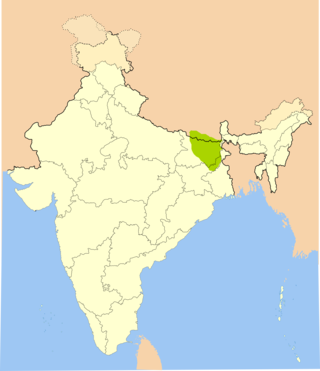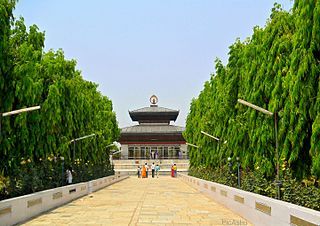Related Research Articles
Bihari languages are a group of the Indo-Aryan languages. The Bihari languages are mainly spoken in the Indian states of Bihar, Jharkhand, Uttar Pradesh, and West Bengal, and also in Nepal. The most widely spoken languages of the Bihari group are Bhojpuri, Magahi and Maithili.

Mithila is a proposed state in India, comprising the Maithili speaking region of Bihar and Jharkhand. The Maithili language has own traditional script, known as Mithilakshar. It is part of the historical Mithila region. The proposed state will also include Whole Angika and Bajjika speaking districts which are considered to be dialects of Maithili.

Bihar is a state in Eastern India. It is the third largest state by population, the 12th largest by area, and the 15th largest by GDP in 2021. Bihar borders Uttar Pradesh to its west, Nepal to the north, the northern part of West Bengal to the east, and Jharkhand to the south. Bihar is split by the river Ganges, which flows from west to east. On 15 November 2000, southern Bihar was ceded to form the new state of Jharkhand. Only 11.27% of the population of Bihar lives in urban areas as per a 2020 report. Additionally, almost 58% of Biharis are below the age of 25, giving Bihar the highest proportion of young people of any Indian state. The official language is Hindi, which shares official status alongside that of Urdu. The main native languages are Maithili, Magahi and Bhojpuri. But there are several other languages being spoken at smaller levels.

Maithili is an Indo-Aryan language spoken in parts of India and Nepal. It is native to the Mithila region, which encompasses parts of the eastern Indian states of Bihar and Jharkhand as well as the Nepal's Koshi and Madhesh Provinces. It is one of the 22 scheduled languages of India. It is the second most commonly spoken language of Nepal. It is also one of the fourteen provincial official languages of Nepal.

Bhojpuri is an Indo-Aryan language native to the Bhojpur-Purvanchal region of India and the Terai region of Nepal and it is chiefly spoken in eastern Uttar Pradesh, western Bihar, and northwestern Jharkhand in India, as well as western Madhesh, eastern Lumbini, southeastern Gandaki, and southwestern Bagmati in Nepal. Bhojpuri is also widely spoken by the diaspora of Indians descended from those who left as indentured laborers during the colonial era. It is an eastern Indo Aryan language and as of 2000 it is spoken by about 5% of India's population. Bhojpuri is a descendant of Magadhi Prakrit and is related to Maithili, Magahi, Bangla, Odia, Assamese, and other eastern Indo-Aryan languages.

Magahi, also known as Magadhi, is a Indo-Aryan language spoken in Bihar, Jharkhand and West Bengal states of eastern India, and in the Terai of Nepal. Magadhi Prakrit was the ancestor of Magahi, from which the latter's name derives.

Madhepura district is one of the thirty-eight districts of Bihar state, India, and Madhepura town is the administrative headquarters of this district. Madhepura district is a part of Kosi division.

Bhagalpur district is one of the thirty-eight districts of Bihar state, India. Bhagalpur is the oldest district of Bihar. Bhagalpur city is the administrative headquarters of this district.
Bihari is a demonym given to the inhabitants of the Indian state of Bihar. Bihari people can be separated into three main Indo-Aryan ethnolinguistic groups, Bhojpuris, Maithils and Magadhis. They are also further divided into a variety of hereditary caste groups. In Bihar today, the Bihari identity is seen as secondary to caste/clan, linguistic and religious identity but nonetheless is a subset of the larger Indian identity. Biharis can be found throughout India, and in the neighbouring countries of Nepal, Pakistan and Bangladesh. During the Partition of India in 1947, many Bihari Muslims migrated to East Bengal. Bihari people are also well represented in the Muhajir people of Pakistan because of Partition.

Maithils, also known as Maithili people, are an Indo-Aryan ethno-linguistic group from the Indian subcontinent, who speak the Maithili language as their native language. They inhabit the Mithila region, which comprises Northern and Eastern Bihar and Northeastern Jharkhand in India and some adjoining districts of Nepal constituting Madhesh Province in addition to some terai districts of Bagmati and Koshi Provinces.

Professor Radha Krishna Choudhary was an Indian historian, thinker, and writer. He contributed to the historical and archaeological studies of Bihar as well as to Maithili literature. He published numerous original researches on the history of Bihar and was acclaimed as a researcher. He was a professor at Ganesh Dutt College, Begusarai, Bihar and was a noted educationist. His languages of choice for academic works were Hindi and English, and for literary work was Maithili.

Mithila, also known as Tirhut, Tirabhukti and Mithilanchal, is a geographical and cultural region of the Indian subcontinent bounded by the Mahananda River in the east, the Ganges in the south, the Gandaki River in the west and by the foothills of the Himalayas in the north. It comprises certain parts of Bihar and Jharkhand of India and adjoining districts of the Koshi Province, Bagmati Pradesh and Madhesh Province of Nepal. The native language in Mithila is Maithili, and its speakers are referred to as Maithils.
Mithila is a geographical and cultural region located in the Indian subcontinent. The native language is known as Maithili and its speakers are referred to as Maithils. The majority of the Mithila region falls within modern-day India, more specifically in the state of Bihar. Mithila is bounded in the north by the Himalayas, and in the south, west and east by the Ganges, Gandaki and Mahananda respectively. It extends into the southeastern Terai of Nepal. This region was also called Tirabhukti, the ancient name of Tirhut.
Hindi is one of the official languages in the Indian state of Bihar. Although Hindustani is the lingua-franca of the region, the majority of the people natively speak one of the Bihari languages.
Bajjika is an Indo-Aryan language variety spoken in parts of Bihar, India and in Nepal.
Most of the languages of Bihar, the third most populous state of India, belong to the Bihari subgroup of the Indo-Aryan family. Chief among them are Bhojpuri, spoken in the west of the state, Maithili in the north, Magahi in center around capital Patna and in the south of the state. Maithili has official recognition under the Eighth Schedule to the Constitution of India. The official language of Bihar is Modern Standard Hindi, with Standard Urdu serving as a second official language in 15 districts.
Jyotishacharya Pandit Baldev Mishra was a prolific writer of Maithili literature in the 20th century who wrote extensively on several topics in his mother language Maithili. Besides Maithili, he also wrote few books in Hindi and Sanskrit covering a range of subjects related to mathematics, astrology, philosophy and history.
Jayakant Mishra was an Indian scholar and author. He was a professor of English at Allahabad University, and an advocate for the Maithili language, where he petitioned the Government of Bihar to make its language instruction available for primary schools in the area., He worked tirelessly for the statehood of Mithila in India carving out from Bihar and Jharkhand from 1994 till his death.

Angika is an Eastern Indo-Aryan language spoken in some parts of the Indian states of Bihar and Jharkhand, as well as in parts of Nepal.
Usha Kiran Khan was an Indian writer who worked in the Hindi and Maithili languages. She was also an academic historian.
References
- ↑ "मैथिली अकादमी की वेबसाइट का लोकार्पण".
- 1 2 Ojha, P. N. (1987). Bihar, past & present. Kashi Prasad Jayaswal Research Institute. p. 323.
- ↑ Singh, Kumar Suresh; Roy, S. B.; Ghosh, Asok K. (1993). People of India: bio-cultural dimensions. Inter-India Publications. p. 250. ISBN 9788121003254.
- ↑ Annamalai, E.; Jernudd, Björn H.; Rubin, Joan (1986). Language Planning. Central Institute of Indian Languages. p. 192.
- ↑ Davis, Alice Irene (1984). Basic Colloquial Maithili. Motilal Banarsidass. p. xii. ISBN 9780895817624.
- ↑ Yadav, Ramawatar (2011). A Reference Grammar of Maithili. Walter de Gruyter. p. 8. ISBN 9783110811698.